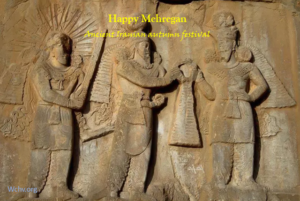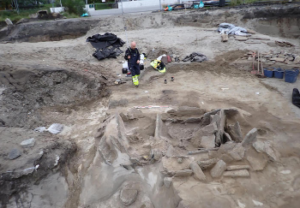 SELJE, NORWAY—A 4,000-year-old stone-lined tomb discovered near the coast of southwestern Norway may hold the remains of the region’s first farmers, according to a Live Science report. The cist, excavated by a team of researchers from the University Museum of Bergen ahead of a construction project, measures about 10 feet long and five feet wide, and has two chambers. The remains of an elderly man, a toddler, and a young woman have been identified. Additional bones in the tomb may represent the remains of another two individuals who had been buried at an earlier date. Traces of dwellings, trash heaps full of animal bones, shell beads, and a stone blade sickle that may have been used to harvest grain have also been uncovered at the site. Team member Yvonne Dahl said that DNA testing of the bones may reveal if the tomb’s occupants were related to one another, and if they were descended from farmers who migrated from the east, or were local people who adopted the practice
SELJE, NORWAY—A 4,000-year-old stone-lined tomb discovered near the coast of southwestern Norway may hold the remains of the region’s first farmers, according to a Live Science report. The cist, excavated by a team of researchers from the University Museum of Bergen ahead of a construction project, measures about 10 feet long and five feet wide, and has two chambers. The remains of an elderly man, a toddler, and a young woman have been identified. Additional bones in the tomb may represent the remains of another two individuals who had been buried at an earlier date. Traces of dwellings, trash heaps full of animal bones, shell beads, and a stone blade sickle that may have been used to harvest grain have also been uncovered at the site. Team member Yvonne Dahl said that DNA testing of the bones may reveal if the tomb’s occupants were related to one another, and if they were descended from farmers who migrated from the east, or were local people who adopted the practice
Europe was the ancient name of Ukraine
The meaning of the name Europe according to Indo-Iranian and Greek sources:
The name Europe in Sanskrit and Greek means the place of the chariot and the place of the good torque holder (eu-rope, chariot). The name of that place is also hidden in the Avesta names Khonireth (the place of the glorious chariots) and Takhmorope (Arpoxais of the Scythians, Tahmorath, the hero of the chariot land):
आरोप्य indecl. Aropya having made to mount [horse, chariot, bus, etc]
सु –prefix su- (hau, eu) good.
आरोप m. Aropa (arbά, Ροπή) rhetorical figure super-imposition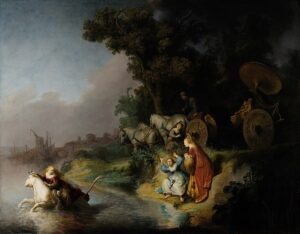
The name Europe in the combination of eury-ope, which means having a widespread forehead, is considered the name of a Phoenician queen.The name Phoenicia, which is considered the home of the goddess Europe (Iphigenia), was based on Phonicia, which means the land of sacrifice human. But this name in the combination of Europe means good torque (good chariot) which is consistent with the Persian word for chariot arava (A-raova in Avesta means very easy to drive) and it seems to be a name for the region of old towers and the whole of Ukraine (Ruthen, Ukrainian) whose names mean spinning and rotating (wheel and chariot). In the Scythian mythology, the golden ax is the symbol of the Taurs of the Ruthenians.
The name Phoenicia, which is considered the home of the goddess Europe (Iphigenia), was based on Phonicia, which means the land of sacrifice human, which is a synonym of the Avestans meaning Tauru (tabar) which means harming, which is also the root of the name Taur (axe), which in Scythian mythology is related to Along with the yoke and the shackle and cup, it is considered the heavenly golden tools of the Scythians. As Herodotus writes about the violence among the Taurians: “The customs of the Taurians are as follows: they worship a goddess who, according to them, has not been touched, and they consider her to be Iphigenia (the strong woman of the waters), the daughter of Agamemnon, and every Greek who is in the sea capture him, or if his ship breaks and he himself falls ashore, they make a sacrifice for this type of slave, in this way, they beat him on the head with a stick. And then they cut off his head from the body and threw his body down from the mountain, and hit his head on the tip of a wooden nail. Any enemy that falls into their hands, they chop his head into small pieces, then each of them takes a piece to his house, installs it in the chimney of the heater of his house and believes that this piece protects the house in the air. Tauors live by looting and war. “
But Taur in the Scythian language, which is closely related to Sanskrit, also means speeder (wheel and cart), which is a synonym of Ruthen and the main name of Ukraine:
त्वरा f. tvarA hurry
त्वरा f. tvarA speed
Based on this, the Avestans name of the land of the European Scythians, Turan, means land of wheels and chariots. Even considering the Avestan word Saka (flowing, sak- in Azeri), the name Sakaiye means the land of wheels and chariots. Previously, they took the Persian word saka (saka), derived from the ancient root sak*, which means “to go, go around”. On the other hand, the Parthians of Scythian descent called the Iranian Plateau, meaning the name of their former homeland (Toran, Europe), Khonirath (Land of Shining Chariots), which is recorded in the Avesta.
The meaning of the name of the Tauri goddess Iphigenia (powerful goddess of waters) is the same as that of Ardvisvar Anahita (powerful and pure goddess of rising waters) and orope (oro-ape, in Avestan [goddess] of vast waters). According to Greek mythology, Europa was kidnapped from the sea with a bull (Tor):
अप्य adj. apya coming from water, जनी f. jani woman
“Iphigenia” means “strong-born,” (strong-woman)
The Indo-European origin of the name Ruthen (the land of the wheel, Ukraine)
The names of Ukraine and Ruthen were originally synonymous with the name Tauria, which means the land of wheels and carriage:
Main Scythian origin of the name Ukraine:
वाहिक m. vAhika (uika) car or vehicle drawn by oxen
लयन n. layana (rayana) place of rest
rayon: area
The name of Ukraine (Uikrainia) was later summarized in Slavic languages and thus it was taken to mean the side land. Because it was called Out Gord (outer garden) by the Vikings. In front of Asegord (Garden of the Gods, Russia), which was the settlement of the Swedish Vikings themselves.
The root of the name Ruthen:
rotary (adj.)
1731, from Medieval Latin rotarius “pertaining to wheels,” from Latin rota “a wheel, a potter’s wheel; wheel for torture,” from PIE root *ret- “to run, to turn, to roll” (source also of Sanskrit rathah “car, chariot;” Avestan ratho; Lithuanian ratas “wheel,” ritu “I roll;” Old Irish roth, Welsh rhod “carriage wheel”). The root also forms the common West Germanic word for “wheel” (originally “spoked wheel”): Old High German rad, German Rad, Dutch rad, Old Frisian reth, Old Saxon rath.
Therefore according the Scythian myth, Scythian king Arpoxais (the king of the land of chariots), whose name come in Avesta in from Takhmorope (the warrior of the land of chariots, Tahmorath) and who rules over the people of Thraspioi (pine fruit eaters, horse breeder, Russian) and Katyarioi (sword people, Hungarian), is meant Herodotus. Among other Scythian myth, gave his name as Gelon (the wheel), which corresponds to the name of the city of Kiev (the capital):
काय m. kAya capital, king
Slavic possessive suffix -ev (meaning belonging to)
The names of his younger brother, Kolaxais (King of the Tribes) and Skyth (Skolav, Slav, Cup) are mentioned and he is considered the king of all the Scythians.
The names of the older brother were Lipoxais (the king of the tattooed people) and Agathyrsi (who had a tattoo tradition), and they were on the side of Moldavia and Romania, and his subjugated people were Aukates (those who have nice houses = Bohmians) and his golden tools were golden yoke (pole, symbol of Poles) and rope (symbol of Thracians).
लेप m. lepa spot
लिप m. lipa smearing, khshais: king
अङ्क m. aGka spot तृषा f. tRSA strong desire
Budin and Gelon are the names of Russians and Ukrainians in Herodotus’ story
Correspondence of the city of Kiev with Caesarea of Ptolemaic maps with ancient Gelon:
The name of the city of Kiev, the capital of Ukraine, which has been attributed to a mythical kingdom called Kay, corresponds to the Caesarea in Ptolemaic maps, which means the place of the ruler. On this basis, the name of the city of Kiev is remembered from the word kavi-veh (attributed to the king) in the language of the Scythians and the ancient Iranians and Sarmatians, and it was their seat of government. In the northwest, the name of the city is seen as Ophlones (Sanskrit, stone city), which can be compared to the current Korosten (Swedish, stone fortress):
उपल m. upala stone
The Caesarea itself of the Ptolemaic maps (the capital, Kiev) seems to be the mythical city of Arpoxais (the king of the land of the wheel) rather than the ancient city of Gelon (the city of the round tool, the wheel). The wooden city that Darius set on fire in the land of the Bodins looks similar to the city of Gelon (Kiev):
ग्लौ f. glau (gola) globe, round
from PIE *kw(e)-kwl-o- “wheel, circle,” suffixed, reduplicated form of root *kwel-
The name of the ancient forest dweller Bodins/Traspians, (pine fruit eaters), corresponds to the Russians (people of the forests) on this side:
भूय n. bhUya (bo) being
दव m. dava[n] forest
त्रस n. trasa wood, pi: to nourish
اروپا نام باستانی اوکراین بوده است
معنی نام اروپا بنا به منابع هندوایرانی و یونانی:
نام اروپا به لغت سنسکریت و یونانی به معنی محل ارابه و محل دارندهٔ گشتاور خوب (ایو–روپه، ارابه) است. نام آنجا در نامهای اوستایی خونیرث (محل ارابه های با شکوه) و تخموروپه (آرپوکسائیس سکاها، تهمورث، پهلوان سرزمین ارابه) نیز مستتر است:
आरोप्य indecl. Aropya having made to mount [horse, chariot, bus, etc]
सु– prefix su- (hau, eu) good.
आरोप m. Aropa (arbά, Ροπή) rhetorical figure super-imposition
نام اروپا را در ترکیب eury-ope به معنی دارای پیشانی بلند نام ملکه ای فینیقی شمرده اند. ولی این نام در ترکیب eu- rope به معنی گشتاور نیک (ارابۀ خوب) است که با واژۀ ارابۀ فارسی (آ–رَئوه اوستایی یعنی بسیار آسان رانده شونده) همخوانی دارد و به نظر می رسد نامی بر منطقۀ تاورهای کهن و کُل اوکراین (روتِن های اوکراین) بوده است که نامهایش معنی گردنده و چرخنده (چرخ و ارابه) را می دهند. در اساطیر سکایی تبر زرین سمبل تاورهای تبعۀ روتن ها آمده است.
نام فینیقیه که موطن الهه اوروپا (ایفی ژنی) به شمار آمده در اساس فونیکیه بوده است به معنی سرزمین قربانی کردن که مترادف معنی اوستایی تَئوروَ (تائور) به معنی آسیب رساندن است که ریشهٔ نام تَوَر (تبر) هم است که در اساطیر سکایی به همراه گاو آهن و قید و پیاله، ابزار زرین آسمانی سکاها به شمار رفته است. چون هرودوت در مورد خشونت در نزد تائورها می نویسد: «عادات تائورها چنین است: ربّة النوعی را می پرستند که به عقیدهٔ آنها لمس نشده است و او را ایفی ژنی (زن نیرومند آبها) دختر آگاممنون می دانند و هر یونانی را که در دریا اسیر کنند، یا کشتی او بشکند و خود او به ساحل افتد، برای این ربّة النوع قربانی می کنند، بدین ترتیب، که چماقی سر او می کوبند. و بعد سر او را از بدن جدا کرده و جسدش را از کوه به زیر افکنده، سرش به نوک میخ چوبین می زنند. هر دشمن که به چنگ آنها بیفتد، سرش را ریز ریز می کنند، بعد هر یک از آنها قطعه ای را به خانهٔ خود برده، به دودکش بخاری خانه اش نصب می کند و عقیده دارد که این قطعه در هوا خانه را محفوظ می دارد. گذران تائورها از غارت و جنگ است. «
ولی تائور در زبان سکاها که با زبان سنسکریت قرابت نزدیک داشته معنی شتابنده (چرخ و گاری) نیز می داده است که این هیئت مترادف نام روتِن و هیئت اصلی نام اوکراین است:
त्वरा f. tvarA hurry
त्वरा f. tvarA speed
بر این اساس نام اوستایی سرزمین سکاهای اروپایی یعنی توران به معنی سرزمین چرخ و ارابه بوده است. حتی نظر به واژهٔ اوستایی سَچ (روان شدن، سَک– در آذری) نام سکائیه نیز معنی سرزمین چرخ و ارابه را می داده است. قبلاً هم واژهٔ فارسی سکا (saka) را، مشتق از ریشه باستانی sak*، به معنی «رفتن، گشتن، گردیدن» گرفته اند. از سوی دیگر پارتهای سکایی تبار فلات ایران را به معنی نام موطن سابق خود (توران، اروپا) خونیرث (سرزمین ارابه های درخشان) نامیده اند که در اوستا ثبت شده است.
نظر به معنی نام الههٔ تائوری ایفی ژن (الههٔ نیرومند آبها) او با اردویسور اناهیتَ (الههٔ نیرومند و پاک آبهای بالنده) و اوروپه (اورو–آپه، در معنی اوستایی [الههٔ] آبهای گسترده) یکی است. مطابق اساطیر یونانی اوروپه از راه دریا با مرکب گاونر سواریش (تور) ربوده شد:
अप्य adj. apya coming from water
जनी f. jani woman
“Iphigenia” means “strong-born,” (strong-woman)
ریشهٔ هندواروپایی نام روتِن (سرزمین چرخ، اوکراین)
نامهای اوکراین و روتن در اصل مترادف نام تائوریه به معنی سرزمین چرخ و گاری بوده اند:
ریشهٔ سکایی اصلی اوکراین:
वाहिक m. vAhika (uika) car or vehicle drawn by oxen
लयन n. layana (rayana) place of rest
rayon: area
نام اوکراین (اویکراین) بعداً در زبانهای اسلاوی تلخیص یافته و بدین صورت در آمده و به معنی سرزمین کناری گرفته شده است. چون آنجا در نزد وایکینگها اوت گورد (باغ بیرونی) خوانده شده است. در مقابل آسه گورد (باغ خدایان، روسیه) که محل استقرار خود وایکینگهای سوئدی بوده است.
ریشهٔ اصلی نام روتِن:
rotary (adj.)
1731, from Medieval Latin rotarius “pertaining to wheels,” from Latin rota “a wheel, a potter’s wheel; wheel for torture,” from PIE root *ret- “to run, to turn, to roll” (source also of Sanskrit rathah “car, chariot;” Avestan ratho; Lithuanian ratas “wheel,” ritu “I roll;” Old Irish roth, Welsh rhod “carriage wheel”). The root also forms the common West Germanic word for “wheel” (originally “spoked wheel”): Old High German rad, German Rad, Dutch rad, Old Frisian reth, Old Saxon rath.
بنابراین از آرپوکسائیس (پادشاه سرزمین ارابه) اساطیری سکاها که نامش در اوستا تخموروپه (پهلوان سرزمین ارابه، تهمورث) آمده و بر مردم تراسپی (اسب پرور، روس) و کاتیار (شمشیرزن، مجار) فرمان می رانده است، پادشاه مردم سکایی اوکراین منظور بوده است که هرودوت ضمن اسطورهٔ سکایی دیگر نام وی را گلْن (دارای دژ مدور) آورده که با خود نام شهر کیف (پایتخت) مطابق میگردد:
काय m. kAya capital, king
Slavic possessive suffix -ev (meaning belonging to)
نامهای برادر کوچک وی، کولاکسائیس (پادشاه قبایل) و اسکیث (اسکولاو، جام) آمده و پادشاه تمامی سکاها به شمار رفته است.
نامهای برادر بزرگتر، لیپوکسائیس (پادشاه مردم خالکوبی شده) و آگاتیرسی (که سنت خالکوبی داشته اند) بوده و در سمت ملداوی و رومانی بوده اند و مردم تحت فرمان او ائوکاتها (کسانی که خانه های خوب دارند= بوهمیان) و ابزار طلایی او یوغ طلایی (نماد لهستانی ها) و طناب (نماد تراکیائیها) بوده اند:
लेप m. lepa spot
लिप m. lipa smearing
khshais: king
अङ्क m. aGka spot
तृषा f. tRSA strong desire
بودین و گلون نام روسها و اوکرائینیها در خبر هرودوت
مطابقت شهر کیِف با سزاریای نقشه های بطلمیوسی و گِلون باستانی:
نام شهر کیِف پایتخت اوکراین که آن را به پادشاهی اساطیری به نام کِی منتسب کرده اند، با سزاریای نقشه های بطلمیوسی به معنی محل فرمانروا مطابقت می نماید. بر این پایه نام شهر کیف از کلمۀ کَوی–وه (منسوب به شاه) در زبان سکاها و سرمتهای ایرانی باستانی ایرانی زبان به یادگار مانده است و آنجا مقر حکومتی ایشان بوده است. در شمال غربی آن نام شهری به صورت Ophlones (به سنسکریت یعنی شهر سنگی) دیده میشود که قابل تطبیق با Korosten حالیه (به سوئدی یعنی دژ سنگی) است:
उपल m. upala stone
به نظر می رسد خود سزاریای نقشه های بطلمیوسی (پایتخت، کیف) به جای شهر گِلون باستانی (شهر ابزار گرد، چرخ) شهر آرپوکسائیس اساطیری (شاه سرزمین چرخ) است. شهر چوبی که داریوش در سرزمین بودینها آتش زده است مطابق همین شهر گلون (کیف) به نظر می آید:
ग्लौ f. glau (gola) globe, round
from PIE *kw(e)-kwl-o- “wheel, circle,” suffixed, reduplicated form of root *kwel-
نام بودینها/تراسپیان جنگلی باستانی، خورندگان میوهٔ کاج این سمت با روسها (مردم بیشه ها) مطابقت می کند:
भूय n. bhUya (bo) being
दव m. dava[n] forest
त्रस n. trasa wood
pi: to nourish
War and the danger of destruction of historical monuments in the Middle East
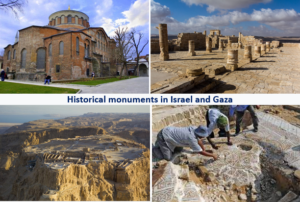 The region involved in the Hamas-Israel conflict has been a cradle of multiple civilizations. It has seen many of the world’s oldest cultures and civilizations. From ancient Canaanite cities to Roman ruins, from Byzantine churches to Islamic mosques, every stone tells a unique ancient story. Yet photos taken over the weekend have shown various destroyed mosques and buildings amid the conflict.
The region involved in the Hamas-Israel conflict has been a cradle of multiple civilizations. It has seen many of the world’s oldest cultures and civilizations. From ancient Canaanite cities to Roman ruins, from Byzantine churches to Islamic mosques, every stone tells a unique ancient story. Yet photos taken over the weekend have shown various destroyed mosques and buildings amid the conflict.
Historians and archaeologists have long expressed deep concern over the loss of these rich archaeological and architectural heritage sites in the region, which has already suffered alarming destruction and negligence.
Study Suggests Hominins Wore Shoes
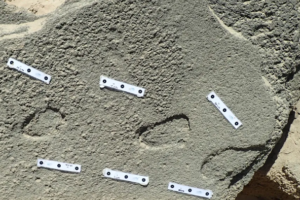 JOHANNESBURG, SOUTH AFRICA—According to a statement released by Wits University, Bernhard Zipfel of Wits University and his colleagues made flip-flops from natural materials, similar to those worn by hunter-gatherer San people today. The researchers then wore the sandals while walking along beaches on South Africa’s Cape Coast. When they compared computerized images of their resulting footprints with photographs of human trackways dated to between 70,000 and 150,000 years ago, the researchers detected “amazing correlations,” Zipfel said. Hominins would have worn shoes to protect their feet from the very sharp rocks along the Southern Cape Coast at the time, he explained. “It makes sense that people would use footwear to protect themselves. One hundred thousand years ago, an injury to the foot could have been fatal,” he concluded.
JOHANNESBURG, SOUTH AFRICA—According to a statement released by Wits University, Bernhard Zipfel of Wits University and his colleagues made flip-flops from natural materials, similar to those worn by hunter-gatherer San people today. The researchers then wore the sandals while walking along beaches on South Africa’s Cape Coast. When they compared computerized images of their resulting footprints with photographs of human trackways dated to between 70,000 and 150,000 years ago, the researchers detected “amazing correlations,” Zipfel said. Hominins would have worn shoes to protect their feet from the very sharp rocks along the Southern Cape Coast at the time, he explained. “It makes sense that people would use footwear to protect themselves. One hundred thousand years ago, an injury to the foot could have been fatal,” he concluded.
https://www.archaeology.org/news/11877-231103-hominins-trackway-shoes
Circular Maya Structure Uncovered in Southern Mexico
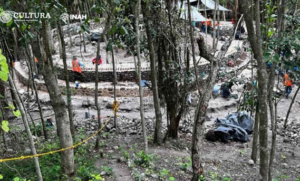 CAMPECHE, MEXICO—Newsweek reports that researchers from Mexico’s National Institute of Anthropology and History (INAH) working in southern Mexico at the Maya site of El Tigre have uncovered a circular structure that may have supported a temple dedicated to Kukulcán, a serpent deity. The presence of the building supports the idea that El Tigre may be Itzamkanac, a settlement described in the late sixteenth century in the Paxbolón Maldonado Papers. The work states that the city of Itzamkanac featured temples dedicated to four deities, including Kukulcán. “This building broadens our knowledge of the late occupation of El Tigre,” said INAH’s general director, Diego Prieto. “Circular structures generally correspond to the early Postclassic period between A.D. 1000 and 1200, when the Maya zone had links with other regions in Mesoamerica,” he explained. Similar round structures have been found at the Maya sites of Edzná, Becán, Uxmal, and Chichen Itzá.
CAMPECHE, MEXICO—Newsweek reports that researchers from Mexico’s National Institute of Anthropology and History (INAH) working in southern Mexico at the Maya site of El Tigre have uncovered a circular structure that may have supported a temple dedicated to Kukulcán, a serpent deity. The presence of the building supports the idea that El Tigre may be Itzamkanac, a settlement described in the late sixteenth century in the Paxbolón Maldonado Papers. The work states that the city of Itzamkanac featured temples dedicated to four deities, including Kukulcán. “This building broadens our knowledge of the late occupation of El Tigre,” said INAH’s general director, Diego Prieto. “Circular structures generally correspond to the early Postclassic period between A.D. 1000 and 1200, when the Maya zone had links with other regions in Mesoamerica,” he explained. Similar round structures have been found at the Maya sites of Edzná, Becán, Uxmal, and Chichen Itzá.
On this occasion of Cyrus the Great Day – 2023
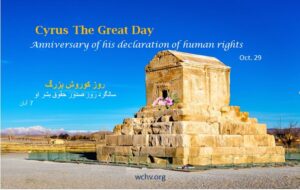 The address of Cyrus the Great to us and to the Middle East.
The address of Cyrus the Great to us and to the Middle East.
We are standing on the threshold of Cyrus the Great Day, the anniversary of the declaration of his eternal charter, addressed to us 2500 years ago. The charter was written during dark days, for which he wanted to bring light and his magnificent decree. Today once again, these words speak to us as we witness imprisonment, torture, and the endless killing of freedom seekers in our land and hostile and tragic events in the Middle East. Those words once again have a resounding meaning and remind us how the first charter of human rights was born.
Ten years ago, while Cyrus the Great’s Cylinder was shown in the United States for several months, Neil MacGregor, a famous historian and former Director of the British Museum, gave an interesting speech, calling Cyrus’ charter one of the greatest declarations of human ideals in history. In his remarks, Mr. MacGregor came to the intelligent conclusion that the charter can once again play an effective role, especially for the Middle East where religions have divided, because Cyrus’ charter is still the strongest and most effective voices in the core of all discussions to bring people from different religions together.
In the past few decades, the events that have happened to our homeland Iran as well as to other countries in the Middle East show that this view of Cyrus’ charter is just as important today. Therefore, the question arises whether now more than ever before is the time to honor the great Cyrus and his manifesto, and to distance ourselves from the leaders and people who have made religion a weapon for suppression, destruction, and war.
We at the Pasargad Heritage Foundation call on all Iranians around the world to celebrate Cyrus the Great Day and to salute the name and memory of a great man. As his peacemakers entered Babylon, many of his soldiers marched for friendship in Babylon, and he did not let anyone be intimidated in all the lands of Sumer and Akkad. He rescued the oppressed people from their helplessness, returned the displaced people to their homes, saved the slaves from poverty, and commanded that everyone should be free to choose their religion and place of residence.
Blessed is the day of Cyrus the Great (October 29th / 7th of Aban).
Sincerely,
Shokooh Mirzadegi
Pasargad Heritage Foundation
Happy Mehregan – Festival of Light and Kindness Video Published
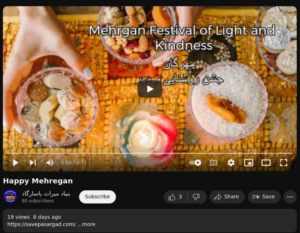 Happy Mehregan! A new video has been published. View it online at:
Happy Mehregan! A new video has been published. View it online at:
https://youtube.com/shorts/ilchJbhSCjU?feature=share
.
Mehregan: National Celebration of Iranians
Persian Caravanserai Recognized as Unesco Word Heritage
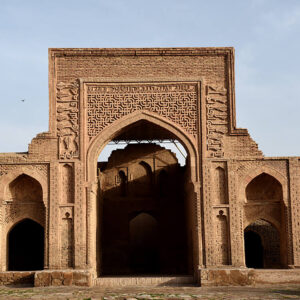 Caravanserais were roadside inns, providing shelter, food and water for caravans, pilgrims and other travellers. The routes and the locations of the caravanserais were determined by the presence of water, geographical conditions and security concerns. The fifty-four caravanserais of the property are only a small percentage of the numerous caravanserais built along the ancient roads of Iran. They are considered to be the most influential and valuable examples of the caravanserais of Iran, revealing a wide range of architectural styles, adaptation to climatic conditions, and construction materials, spread across thousands of kilometres and built over many centuries. Together, they showcase the evolution and network of caravanserais in Iran, in different historical stages.
Caravanserais were roadside inns, providing shelter, food and water for caravans, pilgrims and other travellers. The routes and the locations of the caravanserais were determined by the presence of water, geographical conditions and security concerns. The fifty-four caravanserais of the property are only a small percentage of the numerous caravanserais built along the ancient roads of Iran. They are considered to be the most influential and valuable examples of the caravanserais of Iran, revealing a wide range of architectural styles, adaptation to climatic conditions, and construction materials, spread across thousands of kilometres and built over many centuries. Together, they showcase the evolution and network of caravanserais in Iran, in different historical stages.
Sunken Greek Temple Found Off the Coast of Egypt
 ALEXANDRIA, EGYPT news reports that a temple dedicated to the Greek goddess Aphrodite was discovered at the underwater site of the city of Thonis-Heracleion in Abu Qir Bay by a team of Egyptian and French archaeologists from the European Institute for Underwater Archaeology. Mostafa Waziri of Egypt’s Supreme Council of Antiquities said that the temple has been dated to the fifth century B.C. Artifacts made of bronze and ceramic were found within the temple, he added. Earthquakes, tsunamis, and rising sea levels are thought to have caused much of the city of Thonis-Heracleion to sink in the second century B.C
ALEXANDRIA, EGYPT news reports that a temple dedicated to the Greek goddess Aphrodite was discovered at the underwater site of the city of Thonis-Heracleion in Abu Qir Bay by a team of Egyptian and French archaeologists from the European Institute for Underwater Archaeology. Mostafa Waziri of Egypt’s Supreme Council of Antiquities said that the temple has been dated to the fifth century B.C. Artifacts made of bronze and ceramic were found within the temple, he added. Earthquakes, tsunamis, and rising sea levels are thought to have caused much of the city of Thonis-Heracleion to sink in the second century B.C

